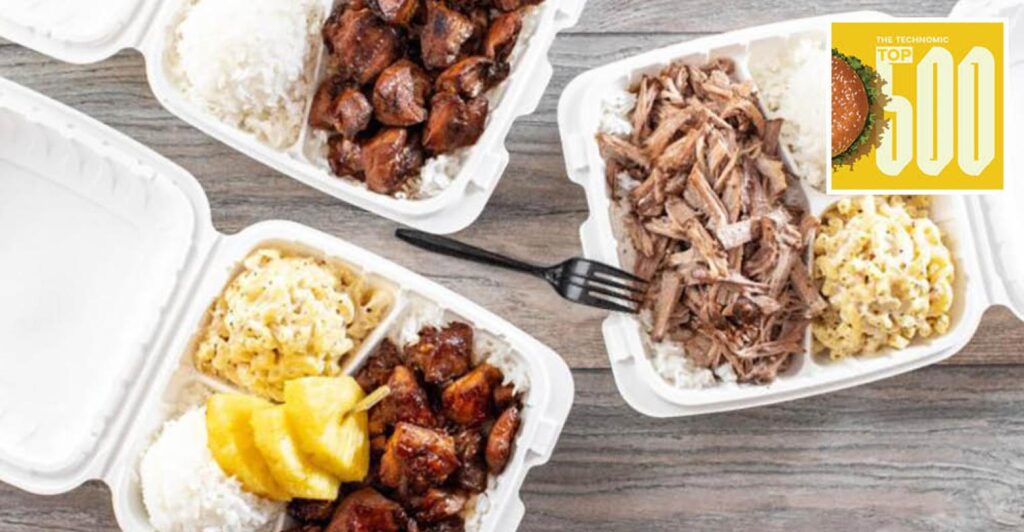How changing demographics are influencing the growth of some restaurant brands
Hawaiian, Asian, and Hispanic populations in the U.S. have grown significantly in the past 20 years, accelerating the sales and unit count pace of several restaurants.
10 July 2024
Share this exclusive content from Saladplate

The Hawaiian Bros plate lunch consists of proteins like slow-roasted pulled pork and marinated teriyaki chicken paired with traditional sides of white rice and macaroni salad. | Photo Credit: Kathy Tran
To understand some of the fastest growing restaurant concepts in the U.S., it’s important to understand some of the fastest growing demographics in the U.S. Doing so illustrates an intriguing yet simple correlation; consumers are becoming more diverse and that is influencing culinary diversity as well. More availability and exposure create more trial and it all becomes one big virtuous cycle.
Consider, for instance, Hawaiian cuisine, which includes everything from Spam musubi and kalua pig to katsu chicken, all served in a plate lunch format. There are several high-growth concepts on Technomic’s 2023 Top 500 list that focus on such cuisine; among them are, Mo’Bettahs, L&L Hawaiian Barbecue, Ono Hawaiian BBQ, and Hawaiian Bros. Island Grill. Mo’Bettahs finished 2023 with about $80 million in sales and about 50 locations, or just over 40% year-over-year sales growth and just over 31% year-over-year unit-count growth. L&L Hawaiian Barbecue grew sales in 2023 by nearly 11%, while unit count was up 6.1%. For Ono, sales were up over 11% year-over-year, while unit count was also up nearly 6%. And, for Hawaiian Bros., sales jumped over 10%, while its footprint grew by nearly 30% to 48 locations.
What’s driving that growth? It could be explained – at least in part – by a demographic shift of native Hawaiians moving to the U.S. mainland. According to the 2020 U.S. Census, more Hawaiians now live on the continent than in Hawaii proper for the first time ever — 53% compared to 47%. Native Hawaiian and other Pacific Islanders were the fastest growing populations in the U.S. from 2000 to 2002, marking a 120.3% increase.
It’s hardly the only growing (and influential) group, however. The Asian population during that same timeframe grew about 105%, per the Census. It’s likely no coincidence, then, that there have also been several fast-growing Asian concepts. Chief among them? Panda Express, which has been leapfrogging giants like Popeyes, KFC, Pizza Hut, Arby’s, Dairy Queen, and Olive Garden for the past several years, signaling demand for a quick, Asian-influenced meal. Panda now generates about $5.9 billion in sales, versus $3.98 billion in 2019.
But there are also plenty of high-growth Asian concepts that haven’t been around as long that have captured plenty of attention as well. Concepts like KPOT Korean BBQ and Hot Pot have generated staggering sales (251%) and unit count (243%) growth from 2022 to 2023. Gen Korean BBQ, which went public last year, experienced nearly 11% sales growth in 2023, as well as 20% unit growth. Meanwhile, Jinya Ramen Bar was up 21% in sales and 30% in units, while Teriyaki Madness was up nearly 19% and 14%. Further, BonChon, Bibibop, Rock N Roll Sushi, Kura Sushi, Hawkers Asian Street Food, and Nobu all turned in impressive growth numbers from 2022 to 2023.
The Hispanic population is the third-fastest growing in the U.S., with about an 80% clip throughout the past two decades. Traditional Hispanic cuisine spans everything from street tacos to paella to enchiladas. To leverage Technomic’s data that means homing in on Mexican cuisine specifically, to which there are – again – several concepts growing sales and unit count at a remarkable pace, including and especially those in the fast casual taco category, like Torchy’s Tacos, Condado Tacos, Bartaco, Velvet Taco, and Barrio Tacos.
Simply put, and as Mo’Bettahs CEO Rob Ertmann explained, with these demographic shifts, more people are exposed to global cuisines now and are figuring out what it is. Notably, the white space potential in these categories is significant, as most of these concepts are emerging brands.

Source: Nation’s Restaurant News



